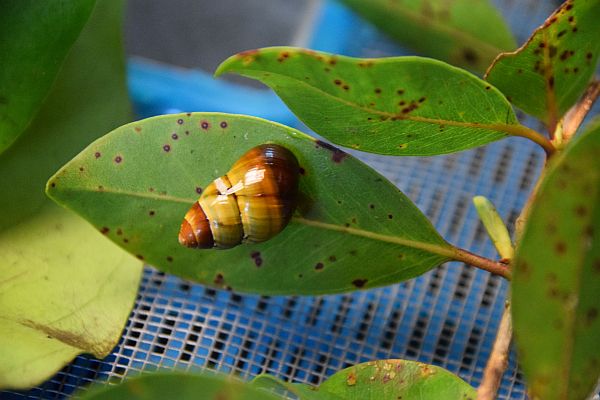The four of us stood gathered around the workbench, counting snails. The adults were easy enough to spot amongst the vegetation spread out in front of us. The juveniles, however – usually referred to as keiki, using the Hawaiian term for a child – were a different matter altogether. Their tiny forms, not more than a millimetre or two in length, could easily be missed, mistaken for a mark on a leaf or branch. For this reason, every piece of vegetation was checked twice. In all, there were forty snails in this particular container – eighteen adults and twenty-two keiki. As we finalised the count, the snails now gathered into two Petri dishes, I took the opportunity to get a closer look at their incredible, brown-green conical shells glistening under the laboratory lights like ‘living jewels’.
This was my first close-up encounter with Achatinella lila, a critically endangered Hawaiian tree snail. The last known free-living population of the species disappeared from the forests of the Ko’olau mountains on O’ahu a couple of years ago. ‘Disappeared’ is not really the right word. They were decimated, consumed by introduced predators like rats and a carnivorous snail called Euglandina rosea, which tracks the slime trails of the native snails to consume them with disturbing efficiency. After more than a century of other impacts – especially the loss of habitat to ranching, plantations, and the military, and a long and spirited period of shell collecting – these predators are now finishing off the job and eating many of Hawai’i’s remaining snail species out of the world.
My encounter with Achatinella lila took place in the ‘snail ark’, a captive breeding lab run by the Hawai’i State Government’s Snail Extinction Prevention Program (SEPP), and headed up by David Sischo. Achatinella lila is just one of the thirty-eight rare snail species – several of which do not exist anywhere else – that have found a new home in this place. Drawn into the architectures of conservation care, these snails join a growing number of species that are now only able to survive with a little, or a lot, of help from people.
Endangered species management is frequently likened to emergency room work, accompanied by its own forms of intensive care, intervention and even triage. But, increasingly, this is looking like the wrong metaphor. Intensive care implies that there is a meaningful prospect of recovery. That, with some attention, species might be patched up and sent on their way. Tellingly, however, the SEPP program is explicitly one of ‘extinction prevention.’ As David explained to me, recovery or restoration of many of these species is just not possible, at least for the time being. The best that can be done is to hold onto them in case something changes. But the prospects for that change are slim and diminishing. In this light, perhaps it makes more sense to understand these spaces as something more akin to a hospice than an emergency room: places that these species are not likely to ever really exit in any full sense.
***
The snail ark is a peculiar environment, housed within a forty-four-foot long trailer on a lush hillside. Here, small groups of snails live out their lives in plastic containers, like the terraria you might keep a pet rat or fish in at home. Unlike the garden snails more familiar to most of us, these snails do not consume living vegetation. Instead, the diet of a tree snail like Achatinella lila consists solely of a thin layer of fungi and microbes that they scrape from the surface of leaves. Other rare snails in the lab are ground-dwellers who consume and recycle decaying leaf matter. Stocked up with the appropriate vegetation, these containers are themselves stored within six large environmental chambers that look quite a lot like refrigerators but do the more complex job of replicating the temperature and moisture conditions of various parts of the Hawaiian forest. In short, then, the ark aims to provide a series of simulated forest microcosms packed into a single secure unit.
Keeping the lab’s thousands of slimy inhabitants healthy is a detailed, time-consuming work of care. The bulk of this work falls to the lab’s manager, Lindsay Renshaw. Every two weeks, each container needs to be taken out and refreshed, a process that involves counting and monitoring the occupants, sterilizing the containers, and replacing the vegetation. With about seventy containers in the facility, when the last one is finished it is time to begin with the first again. This Sisyphean labor is a vital part of preventing disease from taking hold.
Alongside this captive facility, SEPP also co-manages six small fenced ‘exclosures’ with the Oahu Army Natural Resources Program. Surrounded by a moat of cleared land, these utilise a range of ingenious barriers to keep out introduced predators. From solar-powered electric shocks to spikey surfaces that are difficult for carnivorous snails to cross over, the exclosures produce bubbles of snail diversity within otherwise hostile environments.
But the ark and the exclosures can only protect a fraction of Hawai’i’s snails. These islands were once home to one of the most diverse assemblages of terrestrial snails found anywhere on earth, roughly eight hundred species. To put this in context, Hawai’i had two-thirds of the number of snail species found in the whole of North America, a landmass roughly 1700 times the size. Sadly, however, only about two hundred Hawaiian species are now thought to remain, and the majority of these are threatened with extinction – a significant number of them living only within the lab or an exclosure.
All over the island of O‘ahu, and beyond when resources allow, David and the five-person SEPP team are engaged in what he thinks about as an ‘evacuation’: trying desperately to locate the last remnants of snail species. Just a few years ago, they would try to take only a small number of snails as a backup, leaving the rest in the forest. In the intervening years, however, David has seen about fifteen formerly robust populations, each comprised of hundreds of snails, completely disappear. As a result, they are now often pulling out every snail they can find.
***
Hawai’i’s snails first captured my attention in 2013, while I was on a research trip to the islands, studying endangered birds. I was introduced to Michael Hadfield, one of the fathers of contemporary snail biology and conservation in Hawai’i (and David’s PhD supervisor). Michael, in turn, introduced me to George. I don’t think George had a name back then. He was often just referred to as ‘the last snail’. Despite over a decade of searching, no other members of the species Achatinella apexfulva could be found. I was fortunate enough to see George a couple more times over the intervening years (tree snails can live for fifteen years or more). Each time I did, I experienced the same feelings of profound sadness, of hopelessness, that I suspect accompany most encounters with ‘endlings’ – the last individuals of their kind.
In January this year, George made headlines in a few newspapers when he passed away, signalling the first official extinction of the year. George has directed much-needed attention to Hawai’i’s snails. His story is immediately compelling and unsettling. His lonely decade in captivity moves people. But the story of George and his species is also that of many other Hawaiian snails, not to mention countless other species around the world. Rather than being a story of exceptional tragedy, George’s story is an exemplar of larger patterns of conservation and extinction, of processes of long-term care that are, in the final analysis, acts of delaying the inevitable. Extinction in slow motion.
With George, it was clear for a long time that there would be no happy ending. With only one individual left there was little chance for a healthy future for this species. But the situation for many of Hawai’i’s other snails is only slightly better. For these species, recovery would require the widespread eradication of the carnivorous snail – something that nobody has any real ideas about how to achieve. Meanwhile, the climate is getting drier and hotter in ways that are unlikely to bode well for moisture-dependent gastropods. While the SEPP team have gotten better and better at keeping snails alive and reproducing in the lab and the exclosures, there is no real prospect for how life beyond these facilities might one day be possible.
Importantly, many of the endemic forest birds that first drew me to the Hawaiian Islands face a similar challenge. Most are now gone, and many of those that hang on do so in captive facilities or shrinking refugia. For them, restoration will likely require the eradication of introduced mosquitoes, vectors for avian malaria. Here too, climate change is exacerbating the situation, with warmer weather enabling mosquitoes to move into some of the few remaining higher-elevation bird populations. In the case of Hawai’i’s snails and forest birds, we are holding on to species as their worlds slip through our fingers.
But, of course, this situation extends well beyond the Hawaiian Islands. Around the world, many species now live out their final days under human care in strange environments, from the zoo to the captive breeding facility. As a recent report by the Intergovernmental Science-Policy Platform on Biodiversity and Ecosystem Services has noted, we are currently experiencing unprecedented and accelerating rates of biodiversity loss in which roughly a million species are at risk of extinction. As the situation gets more dire, bringing species into these safe spaces becomes an appealing option, an ark to weather the Anthropocene storm. But for many of them there will be no release. Reviews of reintroduction programs generally show that the majority of them fail for a variety of reasons, including an inability to secure suitable habitat. Alongside the growth in captive or ex situ conservation environments (in contrast to free animals living in situ), recent decades have also seen a proliferation of inter-situ arrangements, places like the snail exclosures that are somewhere between the wild and captivity. In the words of the anthropologist Deborah Bird Rose, these are ‘zones of suspended life’, places in which the ecological and cultural relationships of a species are largely severed. In this regard, George the snail joins Lonesome George the Pinta Island tortoise, and George the Passenger Pigeon (who, like his eponymous Presidential referent, was survived for a few years by his partner Martha). So many Georges living out their own and their species’ final days in captive isolation.
***
On my most recent visit to the ark, as I helped David and Lindsay to count snails, I found myself in awe of the carefully tended bubble of security that has been crafted here. And yet I am mindful that while some of these species might be restored, for others we are really just slowing down the inevitable fact of extinction. Of course, all species eventually go extinct. The paleontologist George Gaylord Simpson once famously noted that the earth is ‘a charnel house for species’. While life continues on this planet, this will always be the case, but for this brief moment in its history the earth has become something else too. Unable to halt the ongoing destruction of our time, the Anthropocene has become a period in which both the lives and deaths of other species are increasingly being shaped, more or less wisely and consciously, by the actions of (some) humans. Whether we like it or not, we now find ourselves living on a hospice earth.
Owning up to this situation is not about embracing pessimism. The metaphors we think with powerfully structure what is possible. As the sociologist of science Susan Leigh Star has put it: ‘metaphor brings worlds together’. To acknowledge that we are living on a hospice earth is to accept that current approaches to conservation have failed many species and will continue to do so. The simple fact is that ex situ conservation is an approach of last resort. By the time we get here, in many cases it is simply too late. We have known this for decades. Meaningful conservation needs to address larger threats like habitat loss, pollution, the global movement of species, and the breakdown of our climate system. But, time and again, we fail to do so, and people like David and Lindsay are left to tend to species at death’s door.
The anthropologist Anna Tsing and her colleagues have argued that we need to cultivate the ‘arts of living on a damaged planet.’ Perhaps facing up to death and dying is one such art, essential for our times. Doing so might move us beyond the never-ending cycle of news stories in which extinctions, if they are noticed at all, gather a few headlines and are then quickly forgotten. In contrast, the drawn-out deaths of snail species, accompanied as they are by the dedicated work of care for the dying, might demand of us that we confront these beings who stubbornly go on living even after their worlds and possibilities have been so systematically destroyed.
This confrontation is only possible if we can face up to the significance of our time and refuse to look away. Facing up to loss can be affirmative, even transformative. It is also an act of faithfulness to those who are gone, or soon will be. This, it seems to me, is the very least that we owe to Hawai’i’s snails, not to mention the countless other species that might soon join them at the edge of extinction.
Image: an Achatinella lila (Thom van Dooren)






